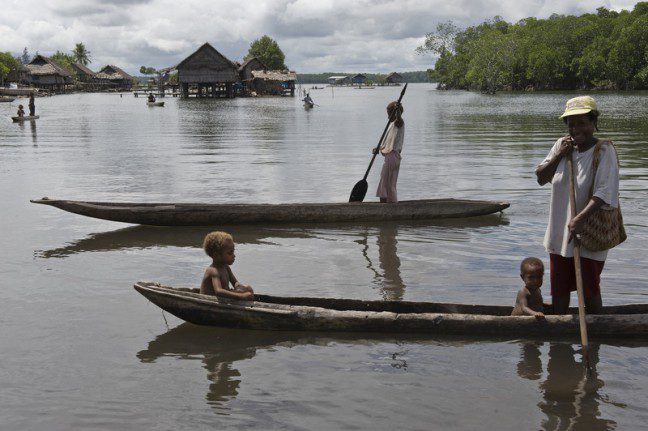Chris Johnson travels to Papua New Guinea to meet people in a very unique village unlike anywhere else on the planet. Kambaramba 1 literally rises up out of the Sepik River and is now surrounded by a deadly, invisible disease infecting the water the makes up its very foundation.
It is 6am on the Sepik River – one of the most epic river systems in the world. I am travelling with the Oxfam humanitarian response team based in Angoram, a small village two hours west of Wewak on the northeast coast of the country. There are no roads to most villages along the river, which acts as a natural highway allowing people to trade Sago palm, fish and other commodities.
Today, buckets, soap, supplies and eight staff are packed tightly into two skinny four and a half meter fibreglass boats with single outboard engines. I am here with cameras in hand to document the team as they respond to a cholera outbreak in a remote, barely accessible wilderness.
As we launch, we navigate through a traffic jam of hand-made dugout wooden canoes loaded with family members from babies to grandparents. Crocodiles are a major risk travelling on the Sepik River; remoteness is another. If you get stuck, it may be a while before anyone hears your call for help.
On my boat is Eva Waramapi, 54. She is the district president for the local council of women in Angoram. She helps Oxfam access communities affected by the cholera outbreak. She tells me that the initial fear of cholera sweeping through this area was overwhelming.
“Everybody was scared… They didn’t know how to protect themselves. The fish was condemned for a month or two.”
A serious infectious disease caused by a water borne pathogen, cholera affects the intestinal system of the body. An infected person experiences vomiting, diarrhoea and severe dehydration. Without immediate medical treatment, cholera may result in death within a day of symptoms beginning.
As we navigate man-made cuts in the riverweed, the village of Kambaramba 1 emerges on the horizon. Inhabited by 3,000 people, a seemingly endless row of traditional thatched houses made of sago palm leaves, bamboo, and wood rise up out of the water. I am in awe trying to figure out how people actually live here, and have for generations with cultural roots firmly set in the past.
Arriving in Kambaramba
We arrive and receive an incredibly warm welcome from Karimbi Wonguwa, 40, and a mother of five. As soon as I set foot onto the slippery thatched floorboards, she tells me of the challenges her family face each day living on a house surrounded by water.
“Water is a big problem for us. We use the same water source for washing our utensils and clothes, and use it to go to the toilet and as well as washing fish.”
Each house is an oasis passed down through generations. Transport, trade, and communication between each home are entirely by canoe. At first glance, it is ethereal, yet spectacular in nature. It is also the perfect storm for a diarrhoeal disease like cholera.
Karimbi’s family dealt with cholera very soon after the outbreak started.
“We collected the same water for drinking, without knowing that it’s infected with cholera. When people drank the water, they started to vomit and have diarrhoea and we did not know what caused it. Many of our family members died of cholera because we did not know that it was cholera.
“We thought it was normal diarrhoea and did not bother to go to Angoram Health Centre for treatment. The centre is also far from our village and that is why many of our family members died.”
To be continued….
What you can do
- Read more about how Oxfam is helping the people of Kambaramba 1
- Donate now to our Water Appeal
This post is part of Blog Action Day 2010

